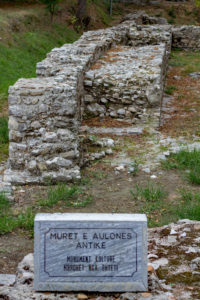Vlora is a large seaside town in southwest Albania and is where the country’s independence was declared in 1912. There is naturally therefore a “National Museum of Independence”:https://www.silvertraveladvisor.com/review/attraction/201395-review-national-museum-of-independence as well as a “Historical and Archaeological Museum”:https://www.silvertraveladvisor.com/review/attraction/201375-review-historical-and-archaeological-museum-of-vlora. However, there are a few other sights, all within a walk of the “Hotel Partner”:https://www.silvertraveladvisor.com/review/accommodation/201321-review-hotel-partner, where we stayed for three nights.
A wide, flat pavement on Boulevard Ismael Qemali, took us to the historic centre. The walk took around 20 minutes, but after the slopes and steps in “Saranda”:https://www.silvertraveladvisor.com/review/place/201219-review-saranda, it was easy going. We passed the theatre Petro Marko, and Park of Hope, with its bust of Marigo Posio, a nationalist born in 1878, who taught women’s literacy under the guise of embroidery classes.
Towards the end, a central path separating the traffic, had been recently planted with new trees which were moored with ropes, and huge freshly dug flower beds ready for planting.
Many of the small shops and buildings were from the communist era, but attempts had been made to improve the look of the area with wall art. However, bearing in mind it was a Saturday afternoon, it was all eerily quiet.
We looked up and saw on high, the regional headquarters of the Bektashi faith which contained the tomb of Kuzum Baba, a spiritual leader. We walked up a dozen or so steps to a statue of Dede Ahmed Mytfar, leader of the world Bektashi community from 1947 to 1980, but decided against heading for the top. Continuing, we came to what was effectively a roundabout and in the centre was the attractive Muradie Mosque, built in 1537 and now a cultural monument.
Behind, we found a large open area, Independence or Flag square, with a large bronze statue, known as the Independence Monument. It depicts various key figures who played a role in the independence movement and above them on a rock, was a flag bearer ready to hoist the double headed eagle of Albania.
On the edge of the square, the Albanian flag flew from the top of a column. Whilst buried nearby was Ismael Qemali, the principal author of the Declaration of Independence, and the country’s first Prime and Foreign Minister from 1912 to 1914.
We also found a short stretch of wall, whose foundations are said to date back to the 4th century AD. The ancient fortifications were rebuilt in the 16th century with eight towers forming an octagon.
On our second day, we headed out in the opposite direction towards the coast. Whilst walking on the incredibly wide pedestrianised promenade, we noticed a couple of smaller trees that had not been battened down with guy ropes. Seeing how they bent considerably, we realised what they are up against – strong coastal winds.
The weather was just right for walking, sunny but with a light breeze, and as the walking was flat, we continued for around 30 minutes until we reached a car park, short jetty and restaurant where we turned around. The sand looked reasonable but in early October, there was no signs of life on the beach or in the sea and there appeared to be few facilities. On the opposite side of the road, there were so many huge hotels and we both agreed, it would be interesting to see it in high summer.
Another option is a boat trip from Vlora to Sazani Island, but although this was included on our itinerary, because it was October, the boats no longer ran. It had once been a military base where you could still see traces of island life from that time. It had also only recently become accessible and so we were really disappointed to miss it.










